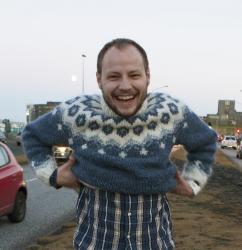I know we’re all pretty sick of trolls in 2016, but trolls were way funnier in 1260. So this recap is gonna revisit a character from last issue’s recap, The Saga of the People of Kjalarnes. While much of the accuracy of most events described in the sagas is dubious at best, the majority of the characters in them were actually real people. Because of this, many of the Sagas feature mentions of or cameos from characters from other Sagas and from Icelandic history.
However, only few of them have direct sequels, which is why we’re going to pick up where we left off in the last issue with this special little nugget called The Tale of Jökull Búason.
Búason Crusoe
If you remember, The Saga of the People of Kjalarnes ended with Búi being killed by his illegitimate 12-year-old half-troll son with some magical assistance from the spurned mother, Princess of the Norwegian trolls. Historical fact. Not dubious at all. So Jökull, the son, flees the scene in shame and takes to the sea. Unfortunately, his ship catches a bad wind and ends up getting wrecked on a mysterious coast months later.
Jökull leaves his surviving shipmates on a rock off the coast and swims to shore, where he conveniently finds an abandoned hall with a fire already burning. He fetches his shipmates, including his bestie Ulfur, and they settle into the hall. When he goes to the shore to look for washed-up supplies, he sees two troll women there.
Beach bodies
Now this is one of the biggest points of confusion in the Sagas: trolls vs. giants (and what exactly the fuck they are). Many Sagas use the words interchangeably but describe these beings in various ways. Fríður, Jökull’s mother and a troll, is described as one of the most beautiful maidens in the world, while these two troll maidens are described as hags, having frowning faces, big noses, and lips that hang down to their tits. They also wear cloaks made of skin. Such distinctions as these have been filed into the “eternal mysteries” folder by medieval scholars and the “didn’t notice/don’t give a shit/nobody does” folder by normal people.
So anyway, they know who Jökull is and decide to force him to marry one of them or else they’ll kill him, so he chops one of their heads off and beats the other one down into the sand. She then agrees to help him. She tells him that her name is Gnípa, she is the youngest of seven but wants her family inheritance, and that they are in Öllumlengrifjörður, (literally “Longer-than-anything-fjord” and genuinely one of the largest fjord systems on the planet) in Greenland.
Jökull and Ulfur meet with Gnípa the next day. She says her brothers have gone to attack the men in the hall, so she leaves to help. Jökull and Ulfur promptly and brutally slaughter her sisters and parents, then also her brothers when they come home. It turns out Gnípa saved many of Jökull’s men from her brother’s attack so they allow her to live with them.
if you’re born into a family rich enough to trade favors with other rich people, you too can become even more ungodly rich on other people’s oil money!
Beachelorette party
One day, she tells Jökull of Skrámur, King of the Greenlandic trolls, and his hunk of a son Grímnir, whom she totally wants to troll-bone. That’s probably even freakier than it sounds. So she sneaks him into their feast using a magic invisibility ring, which he uses to kill off all the trolls as they are drunkenly brawling. When only Grímnir is left, he reveals himself and says he may either marry Gnípa or die, so Grímnir’s like, “Sure, I guess.”
Then it turns out that Skrámur had held Hvítserkur and Marsibil, the Prince and Princess of the Saracens, captive for five years. So naturally Jökull uses the thank-you-boat built for him by Grímnir and Gnípa to sail the kidnapping victims back to the land of the Saracens, where he marries Marsibil and becomes king of the Saracens (roughly all of the Middle East). Hvítserkur marries the Princess of Bláland (literally “Blackland” and roughly WTfuckingF) and everyone lives happily ever after.
Buy subscriptions, t-shirts and more from our shop right here!


















